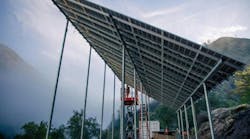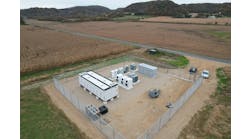Schneider Electric recently signed an agreement with EM-ONE Energy Solutions, an engineering firm in Nigeria, with the aim of creating an industry ecosystem based on renewable energy-centered minigrids built or operated by community stakeholders.
EM-ONE holds a contract to build 30 minigrids to power hospitals in the Nigerian state of Kaduna. It’s aiming to do the same for universities and contribute to the African nation’s rural electrification program.
Schneider is helping optimize the architecture of the projects, develop an industrial platform to integrate the minigrids into containers in Nigeria and manufacture Schneider Electric minigrid solutions under license, according to Paul-François Cattier, Schneider Electric’s vice president, business development, Africa & Middle East.
“Nigeria has become a focal point for distributed solar, renewable energy and minigrid investment due to the size of the market — 75 million people without access to electricity and another 30 million people that are connected to the grid but do not receive any electricity,” said Mark Amaza, who leads strategic communications and research for developing-world, distributed sustainable energy advocacy Power for All.
“This is the second largest population of people without access to electricity in the world after India and the largest in Africa,” he told Microgrid Knowledge. “Another reason is that over the past three years, the government has focused a lot of attention on the off-grid power sector in terms of policies, plans, and targets, such as the 10,000 minigrids by 2023 and the $2 billion investment initiative.”
Enormous potential for electrification in Africa
Schneider and EM-ONE, both finalists for the 2019 Microgrid Knowledge Greater Good Award, have been working with public and private-sector organizations to create a minigrid industry ecosystem in Nigeria for 18 months, according to Schneider. More broadly, the French multinational has installed 700 minigrids in Africa via its Access to Energy program over the past 10 years, mainly for rural electrification.
The minigrids planned by the Schneider-EM-ONE project group will range from 500 kW, enough to meet the energy needs of 10,000 off-grid Africans, all the way to 20 MW, which could serve several hundred thousand people.
“Africa today is comparable to China 40 years ago. In 2050, it will account for 30% of the global population according to the United Nations and could be one of the world’s top five economic powers by 2050,” Cattier said. “The potential for electrification is enormous, not only in rural areas but also for companies who would like their own reliable electricity grid, including banks and their network of agencies and cash dispensers, food and beverage manufacturers, data centers and even electricity providers that currently use power generators and need to switch to hybrid energy production with minigrids.”
Schneider is sourcing components for minigrids locally
Schneider Electric runs a network of sales representatives spread out over 12 African countries. In order to carry out the project it seeks out engineering procurement construction (EPC) companies capable of producing and installing minigrid components and systems locally. “Rather than importing minigrids produced in Europe, Asia or North America, we want to create an African minigrid industry with operators, integrators, investors and local jobs,” Cattier said.
Just 45% of the population reportedly has access to electricity, a statistic that drops to 36% in rural areas.
“The EM-ONE-Schneider Electric agreement which is to build 30 hospital minigrids in Kaduna State is very significant because it shows that not only the federal government, but the state governments as well, are beginning to realize the potential of decentralized renewable energy solutions to provide reliable power supply. It also presents a model for OEMs to partner with minigrid companies in deploying projects, thus reducing the cost of the project deployment and increasing its reliability,” Amaza said in an interview.
Nigeria’s drive to achieve universal energy access
An estimated 200,000 minigrids installed across Africa could power the continent and reach the United Nations Sustainable Development Goal 7 to ensure access to affordable, reliable, sustainable and modern energy for all, according to Schneider and EM-ONE. With a population of more than 200 million, electricity grids are up and running in just one of Nigeria’s 36 states, according to Schneider. Just 45% of the population reportedly has access to electricity, a statistic that drops to 36% in rural areas.
Leading multilateral agencies, joined by Nigerian and foreign private- and public-sector organizations, have been working to improve energy access in Nigeria. Funded by the World Bank, the Nigeria Electrification Project aims to expand cost-efficient access to electricity to nearly 80 million Nigerians who currently lack access to it. Minigrids are expected to be a big part of the solution. The project aims to build out an estimated 850 minigrids to extend electricity access to at least 300,000 households and 30,000 businesses.
“The Nigerian minigrid space is ready to take off, and there is a huge opportunity for investment to scale the market,” said Sachi Graber, an associate at Rocky Mountain Institute and co-author of a 2018 report, Minigrid Investment Report: Scaling the Nigerian Market. “These minigrids could drive a significant economic change in rural Nigeria.”
Nigeria’s Electric Power Sector Reform Act (EPSRA) guides and informs development and the operation of the electricity sector in Nigeria, Amaza explained. The act provides for a Rural Electrification Fund (REF) that subsidizes provision of electricity to rural areas. Funds associated with a recently announced, $2 billion African energy development initiative are going to be channeled through the REF.
“So far, the fund has received about $5.5 million from the federal government as seed funding and $350 million from the World Bank as a long-term loan. The funding is not just for minigrids, but for solar home systems as well,” Amaza said.
Track news about minigrids in Africa. Subscribe to the free Microgrid Knowledge newsletter.







